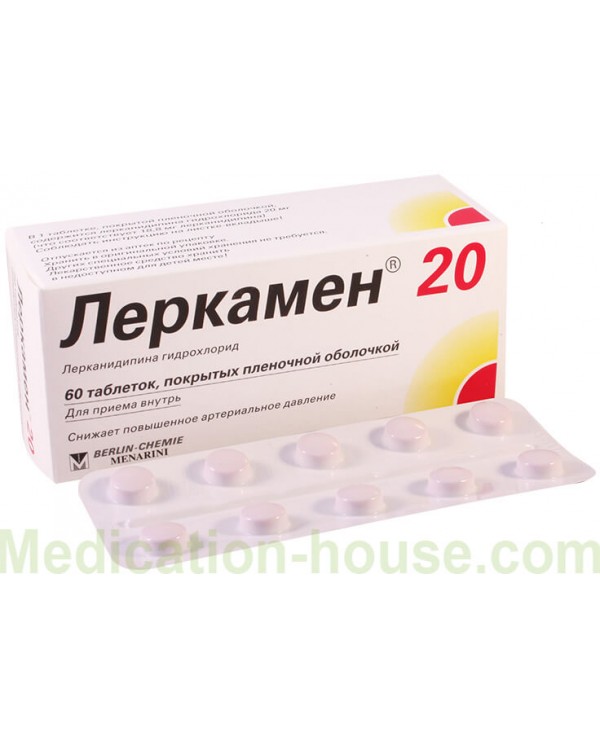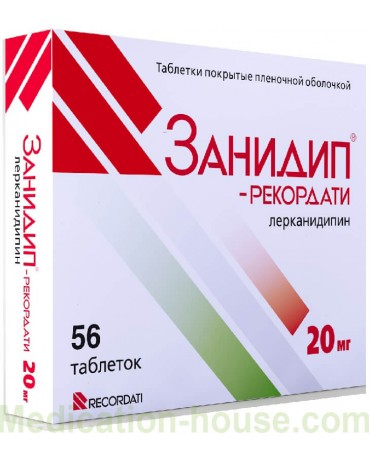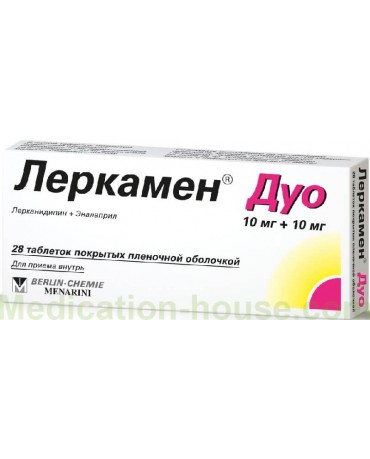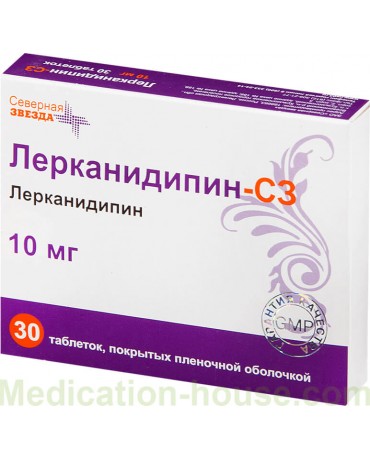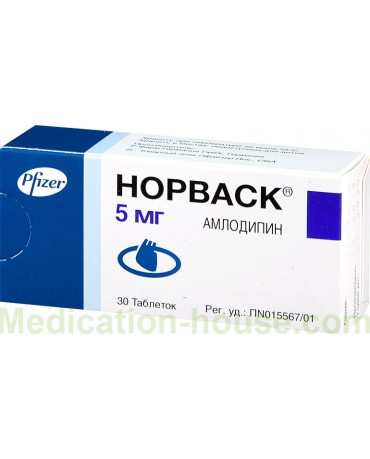Lercamen instruction
You can buy Lercamen on this page
Release form and composition
Dosage form - film-coated tablets: reddish-pink, biconvex, round, on one side there is a dividing line, light yellow at the break (a cardboard box may contain: 1 blister of 7 or 14 tablets; 2, 3 , 4 or 7 blisters of 14 tablets; 5 blisters of 7 or 10 tablets; 6, 9 or 10 blisters of 10 tablets; also each pack contains instructions for the use of Lercamen 20).
Composition for 1 film-coated tablet:
active substance: lercanidipine hydrochloride - 20 mg;
auxiliary components: magnesium stearate - 2 mg; povidone (average molecular weight - 30) - 9 mg; sodium carboxymethyl starch (type A) - 31 mg; microcrystalline cellulose - 78 mg; lactose monohydrate - 60 mg;
shell: Opadry 02F25077 [macrogol 6000 - 0.6 mg; hypromellose - 3.825 mg; iron oxide (III) - 0.075 mg; titanium dioxide - 1.2 mg; talc - 0.3 mg] - 6 mg.
Pharmacodynamics
Lercanidipine belongs to the group of selective slow calcium channel blockers and is a dihydropyridine derivative. The drug inhibits the transmembrane flow of calcium ions into vascular smooth muscle cells. The antihypertensive effect of lercanidipine is due to a direct relaxing effect on vascular smooth muscle cells, which contributes to a decrease in total peripheral resistance.
Due to the fact that lercanidipine has a high coefficient of membrane distribution, even with a relatively short half-life from blood plasma, its antihypertensive effect is prolonged. Due to its high vascular selectivity, the substance has no negative inotropic properties. Against the background of its administration, due to the gradual development of vasodilation, only in rare cases is the appearance of acute arterial hypotension with reflex tachycardia noted.
The drug is a racemic mixture of (+) R- and (-) S- enantiomers, but its hypotensive effect is primarily due to the S-enantiomer.
Pharmacokinetics
After oral administration, lercanidipine is absorbed in full. Its maximum concentration in blood plasma (Cmax) is reached after a period of 1.5 to 3 hours and after taking 10 and 20 mg of the drug is 3.3 ± 2.09 ng per ml and 7.66 ± 5.90 ng per 1 ml respectively.
The enantiomers of lercanidipine (+) R- and (-) S- show a similar pharmacokinetic profile. The time to reach the maximum concentration (TCmax) and the half-life (T1 / 2) are the same for them, and the values of Cmax and the area under the concentration-time curve (AUC) for the (-) S enantiomer are 1.2 times higher.
In the conducted in vivo studies, the interconversion of enantiomers was not observed. In cases of oral administration of lercanidipine after a meal, its absolute bioavailability during the initial passage through the liver is approximately 10%, on an empty stomach it decreases by 1/3, when taken no later than two hours after a fatty meal, it increases 4 times. In this regard, it is not recommended to take the drug after meals.
The concentration of the drug when taken orally in blood plasma is not directly proportional to the dose taken (nonlinear kinetics). The pre-systemic metabolism is saturated gradually. Thus, bioavailability increases with increasing dose. From blood plasma to organs and tissues, lercanidipine is distributed extensively and quickly. Its connection with plasma proteins is at a level of more than 98%. Due to a decrease in the concentration of protein in the blood plasma in hepatic and / or renal failure, the free fraction of the substance may increase. It is metabolized with the participation of the CYP3A4 isoenzyme, with the formation of inactive metabolites. Almost half of the dose taken is excreted through the kidneys, the rest through the intestines. Its elimination is mainly carried out through biotransformation.
On average, the T1 / 2 value varies from 8 to 10 hours. The duration of the therapeutic effect is 24 hours. With repeated oral administration, cumulation of lercanidipine is not observed. It has been shown that in elderly patients, as well as in mild / moderate hepatic and renal failure [creatinine clearance (CC)> 30 ml per minute], the pharmacokinetics of the drug are similar to those in the general population of patients.
The concentration of the drug in the blood plasma in severe renal failure (CC <30 ml in 1 min) and in patients on hemodialysis was higher (approximately 70%). Its systemic bioavailability in moderate / severe hepatic insufficiency is likely to increase, since lercanidipine is mainly metabolized in the liver.
Indications for use
Lercamen is prescribed for the treatment of essential hypertension of I and II severity.
Contraindications
Absolute:
severe renal (CC <30 ml in 1 min) / hepatic impairment;
untreated heart failure;
unstable angina;
obstruction of blood vessels emanating from the left ventricle of the heart;
a period of one month after suffering a myocardial infarction;
lack of lactase, glucose-galactose malabsorption syndrome, lactose intolerance;
childbearing age in patients who do not use reliable methods of contraception;
combined intake with grapefruit juice, cyclosporine, CYP3A4 inhibitors (troleandomycin, itraconazole, ketoconazole, ritonavir, erythromycin);
pregnancy and lactation;
age under 18;
individual intolerance to the components of the drug and other derivatives of the dihydropyridine series.
Relative (Lercamen tablets are used under medical supervision):
elderly age;
dysfunction of the left ventricle of the heart;
mild and moderate hepatic / renal (CC> 30 ml per minute) failure;
coronary heart disease;
sick sinus syndrome (without a pacemaker).
Lercamen, instructions for use: method and dosage
Lercamen tablets are taken orally, preferably in the morning, 1 time per day, at least 15 minutes before meals, without chewing and drinking water (in sufficient quantity). It is recommended to take half a tablet (10 mg) daily. Depending on the individual tolerance of the drug, the dose can be doubled (up to 1 tablet per day).
Since the maximum antihypertensive effect of the drug develops approximately after 14 days from the beginning of its use, the therapeutic dose is selected gradually. It is unlikely that the effectiveness of Lercamen will increase with an increase in its dose of more than 1 tablet (20 mg) per day, while the likelihood of developing adverse events will increase.
According to the data of clinical studies and pharmacokinetic profile, correction of the dosage regimen in elderly patients is not required. However, caution should be exercised at the beginning of therapy in patients of this age group.
When prescribing Lercamen against the background of mild to moderate hepatic / renal failure, it is important to be careful. The initial dose in such cases is half a tablet per day, with its further careful increase to 1 tablet per day. With mild or moderate hepatic insufficiency, the antihypertensive effect of the drug may increase, which may require a correction (decrease) in its dose.
In patients with renal (CC <30 ml per minute) and severe hepatic insufficiency, the appointment of Lercamen is contraindicated.
Side effects
Possible adverse reactions [> 10% - very common; (> 1% and <10%) - often; (> 0.1% and <1%) - infrequently; (> 0.01% and <0.1%) - rarely; <0.01%, including isolated messages - very rare]:
CNS (central nervous system): infrequently - dizziness and / or headache; rarely - drowsiness;
cardiovascular system: infrequently - tachycardia, rush of blood to the skin of the face, a feeling of flutter / pulsation in the region of the heart; rarely - angina pectoris, chest pain; very rarely - fainting, against the background of angina pectoris, the frequency, duration and severity of attacks may increase;
gastrointestinal tract: rarely - nausea / vomiting, epigastric pain, dyspepsia, diarrhea;
skin and subcutaneous fat: rarely - skin rash;
musculoskeletal and connective tissue: rarely - myalgia;
urinary system: rarely - polyuria;
general disorders: infrequently - peripheral edema; rarely - increased fatigue, asthenic syndrome;
immune system: very rarely - hypersensitivity reactions.
Very rare (<1/10000) cases of the development of such side effects as chest pain, myocardial infarction, pollakiuria, gingival hyperplasia, a marked decrease in blood pressure, and a reversible increase in the activity of hepatic transaminases have been recorded.
Overdose
The main symptoms: presumably with an overdose of Lercamen, the same manifestations develop as with an overdose of other dihydropyridine derivatives - peripheral vasodilation with reflex tachycardia and a pronounced decrease in blood pressure.
Therapy: symptomatic treatment; in case of loss of consciousness or a pronounced decrease in blood pressure, cardiovascular therapy is indicated, in cases of bradycardia - the introduction of atropine intravenously.
There have been reports of three cases of lercanidipine overdose when used for suicide in doses of 0.15 / 0.28 / 0.8 g. Patients in all these cases survived.
When taking 0.15 g of the drug combined with alcohol (in an unknown amount), drowsiness was observed; gastric lavage was performed, activated charcoal was used.
In cases of taking 0.28 g of the drug in combination with 0.0056 g of moxonidine, such manifestations as renal failure of mild severity, severe myocardial ischemia and cardiogenic shock were observed; were prescribed cardiac glycosides, furosemide (diuretics), catecholamines in high doses, plasma substitutes.
With the use of 0.8 g of lercanidipine, there was a marked decrease in blood pressure and nausea; a laxative drug and activated charcoal were used, and intravenous dopamine was administered.
There are no data on the effectiveness of dialysis for the elimination of lercanidipine. It is assumed that due to the high bond of the substance with blood plasma proteins, dialysis may be ineffective.
Special instructions
Before using Lercamen, you should consult your doctor.
Influence on the ability to drive vehicles and complex mechanisms
The use of Lercamen can cause fatigue, asthenia, dizziness and drowsiness (in rare cases). In this regard, during the period of therapy, it is important to be careful when driving vehicles and conducting potentially hazardous activities, the implementation of which requires increased attention and speed of psychomotor reactions.
Application during pregnancy and lactation
Lercamen during pregnancy / lactation, as well as patients of reproductive age who do not use reliable methods of contraception, are not prescribed.
In the course of preclinical studies, the teratogenic effect of the drug in rabbits and rats was not revealed, the reproductive function of rats remained unchanged. Since there is no clinical experience with lercanidipine during pregnancy and lactation, but other dihydropyridine derivatives are known to have teratogenic effects in animals, the drug is not recommended during pregnancy, as well as in women of childbearing age who do not use reliable methods of contraception.
It is assumed that due to its high lipophilicity, lercanidipine can pass into breast milk. In this regard, if it is necessary to take Lercamen during lactation, breastfeeding is stopped.
Childhood use
Lercamen is not prescribed to patients under 18 years of age, since there are no data on the safety and effectiveness of its use in patients of this age group.
With impaired renal function
use of Lercamen is contraindicated: severe renal failure (CC <30 ml per minute);
use requires caution: renal failure of mild and moderate severity (CC> 30 ml in 1 min).
For violations of liver function
use of Lercamen is contraindicated: severe hepatic impairment;
use requires caution: mild to moderate hepatic impairment.
Use in the elderly
Prescribing Lercamen to elderly patients requires caution.
Drug interactions
Possible interactions of lercanidipine with other drugs / agents:
metoprolol: the bioavailability of the drug decreases by 50%. This phenomenon is also likely with the combined use of lercanidipine with other β-blockers, which may require a dose adjustment of the former to achieve a therapeutic effect when using such a combination;
inhibitors and inducers of CYP3A4: since the drug is metabolized with their participation, there may be an effect on its metabolism and excretion. Combined use with troleandomycin, erythromycin, ritonavir, itraconazole or ketoconazole is contraindicated;
cyclosporine: increases the concentration of both drugs in the blood plasma. Simultaneous administration of substances is not recommended;
other CYP3A4 substrates [quinidine, amiodarone (class III antiarrhythmics), astemizole, terfenadine]: combined use requires caution;
midazolam: combined administration of 20 mg lercanidipine in elderly patients can increase its bioavailability by almost 40%;
CYP3A4 inducers [anticonvulsants (carbamazepine, phenytoin) and rifampicin]: the antihypertensive effect of the drug may decrease. With combined use, caution should be exercised and blood pressure should be monitored regularly;
cimetidine (in a dose of up to 0.8 g): no significant changes in the concentration of lercanidipine in blood plasma are observed; higher doses of cimetidine may increase the bioavailability and antihypertensive effect of Lercamen 20;
simvastatin (at a dose of 0.04 g): the simultaneous administration of 0.02 g of lercanidipine increases the AUC of simvastatin by 56%, and its active metabolite (β-hydroxy acid) by 28%. This undesirable phenomenon can be avoided by taking lercanidipine in the morning and simvastatin in the evening;
grapefruit juice: may enhance the antihypertensive effect of the drug;
ethanol: may potentiate the antihypertensive effect of Lercamen.
Lercanidipine may be administered in combination with angiotensin-converting enzyme inhibitors, diuretics, or β-blockers.
The combined intake of 0.02 g of the drug in patients constantly receiving β-methyldigoxin does not cause pharmacokinetic interaction. At the same time, in healthy volunteers taking digoxin, its Cmax increases by an average of 33% after taking 0.02 g of lercanidipine on an empty stomach, and AUC and renal clearance change slightly. The presence of symptoms of digoxin intoxication in patients taking this combination should be monitored.
In healthy volunteers who received 0.02 g of lercanidipine with warfarin, there were no changes in the pharmacokinetics of the latter. When the drug was administered concomitantly with fluoxetine (an inhibitor of CYP2D6 and CYP3A4) in elderly patients, no clinically significant changes in the pharmacokinetics of lercanidipine were detected.
Terms and conditions of storage
Store in a place protected from light and moisture at temperatures up to 30 ° C. Keep out of the reach of children.
Shelf life is 3 years.
Reviews about Lercamen
According to reviews, Lercamen is a safe, affordable and effective drug used in the treatment of grade I and II essential hypertension.
Among the shortcomings, patients most often note the development of side effects from the gastrointestinal tract and the central nervous system, as well as in the form of severe edema, arrhythmias, weakness, severe drowsiness, and increased tachycardia.
Terms of sell
You don't need a prescription to buy Lercamen.

